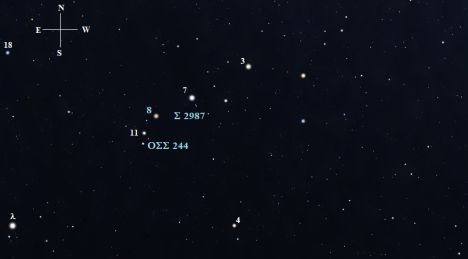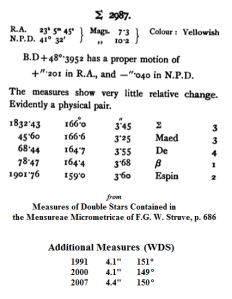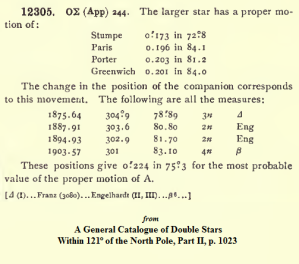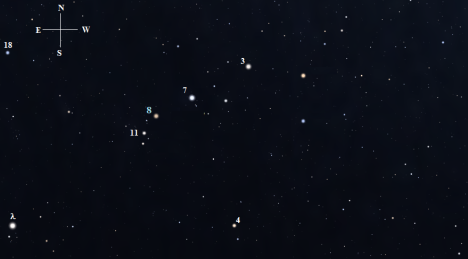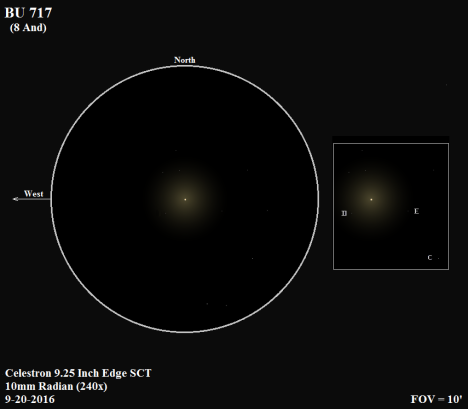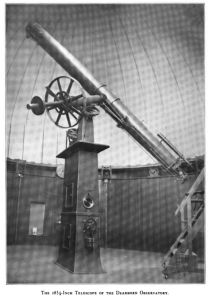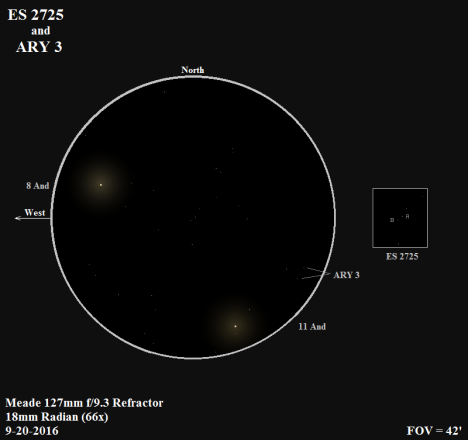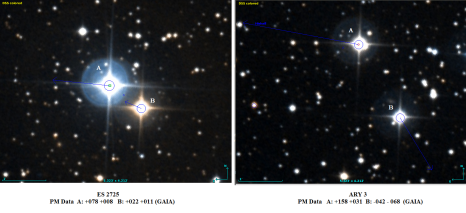Our last trip concentrated on 8 Andromedae/BU 717 and the area immediately southeast of it, so this time we’ll wander a bit farther afield. But we’ll have to take care that our first leap into the darkness doesn’t take us so far from 8 Andromedae that we cut ourselves off from its gravitational grasp — we’ll need that gravitational tug to pull us back to our starting point so we can reverse the process and leap in the opposite direction.
To get oriented once more, here’s a wide look at the stellar terrain where we’ll spend the night:
As I mentioned in the last post, when you first look up into the sky in this general area, the first stars your eyes will be drawn to are the trio of Iota (ι), Kappa (κ), and Lambda (λ) Andromedae. Our destination is the dimmer array of stars to their north and a bit closer to Lacerta. A reliable way to locate the 11-8-7-3 Andromedae grouping is to follow the arc formed by Iota-Kappa-Lambda as it curves toward the southern tip of Cepheus, but keep your eyes on the south side of that arc in order to pick out 11-8-7-3 Andromedae, which are about a third of the distance to Cepheus. Also, as I mentioned before, you’ll probably catch sight of the trio of 8, 7, and 3 Andromedae first, mainly because 11 Andromedae is noticeably fainter than the other three stars (11 Andromedae glimmers weakly at a magnitude of 5.44, while 3 Andromedae gleams more noticeably at a magnitude of 4.66 – not a lot of difference, but it can be enough to make it difficult to visually pluck 11 Andromedae from the sky).
Once you have 11-8-7-3 Andromedae located, point your finder at 8 Andromedae and you’ll find yourself looking at a scene somewhat like this:
The distance from 8 Andromedae to 11 Andromedae is only 29’, whereas 7 Andromedae is about twice as far at 56’, and since both of those two stars will guide us to where we want to go, we’ll center our finder on 8 Andromedae to get started.
As luck would have it, 8 Andromedae is almost equidistant from our two destinations stars (the ones with the turquoise labels, Σ 2987 and OΣΣ 244), so I’ll flip a coin to decide which direction to go first . . . . . and the winner is . . . . . . Σ 2987! Center 7 Andromedae in your finder, scan 30’ to the southwest, and you’re eyes will land on Σ 2987. You’ll notice there’s a tight pair of eighth magnitude stars wedged between 7 Andromedae and Σ 2987 which can be used to keep you on course (the brighter and southernmost of that pair is 7.65 magnitude HIP 114537).
Σ 2987 (STF 2987) HIP: 114420 SAO: 52795
RA: 23h 10.4m Dec: +49° 01’
Magnitudes: 7.42, 10.41
Separation: 4.4”
Position Angle: 150° (WDS 2007)
Distance: 148 Light Years (GAIA)
Spectral Class: A is G1
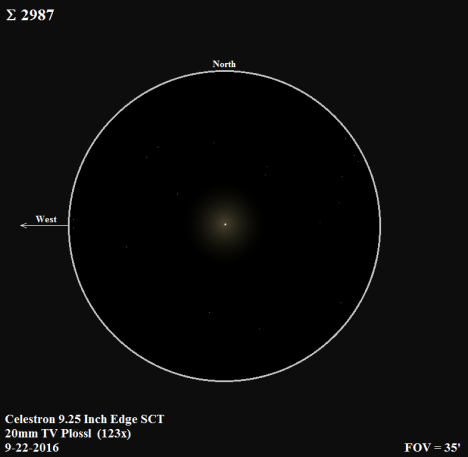
This is a tough one, so click on the sketch to enlarge it and look for the secondary at about midway between the seven and the eight o’clock position. East and west are reversed here to match the view in the SCT.
My first trip in search of Σ 2987 was with a five inch refractor and it was spent trying to split a star that wouldn’t split . . . which was because it was the wrong star. Argh! Not everything goes according to plan when you work in the dark.
I came back a second time with the 9.25 inch SCT and a more deliberate plan, and as you can see from the sketch I found the correct star. Thanks to the larger aperture, it didn’t take much magnification to pry the secondary loose from the primary. Whether I could have done that with the five inch refractor is an open question. Theoretically it should be possible on a night of good seeing, but it would require more magnification than the 123x I used with the SCT.
But the ease with which I split what should have been a more difficult pair left me with a suspicion the secondary is slightly brighter than the 10.41 listed for it in the WDS, although I haven’t been able to confirm that by looking at catalog data. Simbad shows a visual magnitude for it of 10.40 (third star in the list, BD+48 3952B), while UCAC4 and URAT1 were no help whatever since neither catalog lists Vmag values for the secondary. The J and K magnitudes shown in UCAC4 for the secondary yield a visual equivalent of 7.625, which is way too bright, probably a result of the primary overpowering the CCD sensors. It’s also possible the separation is greater than the 4.4” listed for the pair in the WDS, but historical data (discussed below) indicates that’s highly unlikely.
However, there is one thing that we can be certain of: this pair of stars is carving their way through interstellar space in tandem, as this Aladin image with an overlay of Simbad proper motion shows:
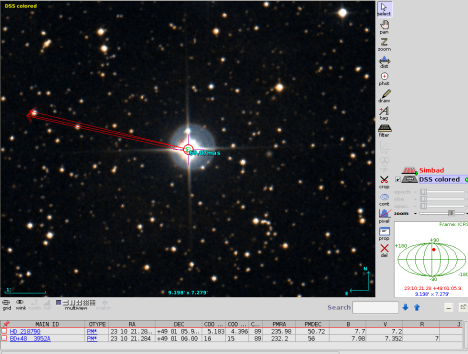
Instead of two arrows, we see three of them super-imposed on this image by Simbad. A third object was sensed at 60.07 milli-arcseconds from the primary (note the blue label), but I haven’t found any data identifying that object. More than likely it’s an error of some kind. Click to enlarge.
You can see the proper motion numbers at the bottom of the image, which show almost identical motion for the primary and secondary. I ran my own numbers by computing the motion using 1999 2MASS coordinates and 2015 GAIA coordinates which resulted in almost identical numbers for the primary, +236 +051.5, and a slightly different number for the secondary, +249 +034, which shows it diverging somewhat from the path of the primary.
Looking back at the measures I could find on Σ 2987, it’s apparent there’s been little change over the years, provided the first measure listed in the WDS from 1828 is excluded. That one shows a separation of 2.8” and a position angle of 172 degrees, which stands out as an exception to the eight measures listed at the right. Since F.G.W. Struve is credited with discovering this pair, I looked in the only likely source for that measure (Catalogus novus stellarum duplicium et multiplicium) and found only coordinates and magnitudes. Lewis shows Struve with an 1832 measure of 3.45” and 166.0 degrees in the excerpt at right from his book, so the 1828 data listed in the WDS remains rather elusive.
On the other hand, looking at the change in separation and position angle in the eight measures listed, it appears this pair has widened slightly since Struve’s 1832 measure, which is in agreement with the proper motion data I generated from the 2MASS and GAIA coordinates. That could be a possible indication of a very slow and ponderous orbit, or, more than likely, the two stars are just linked by a common physical origin, which is reflected in their motion.
Now to our next pair, OΣΣ 244 (STTA 244), which we’ll find is also accompanied by a second pair, OΣ 493 (STT 493). To catch both of them in the same field of view, return to 8 Andromedae for reference, then center your finder on 11 Andromedae, slide it over to the the north corner of your eyepiece, and you’ll find OΣΣ 244 and it’s two companions near the center of the field of view. For reference, here’s our last chart again (the unlabeled star perched between 11 Andromedae and OΣΣ 244 is OΣ 493).
OΣΣ 244 (STTA 244) HIP: 115171 SAO: 52912
RA: 23h 19.7m Dec: +48° 23’
Magnitudes AB: 6.41, 10.15 AC: 6.41, 11.50
Separations AB: 100.6” AC: 119.2”
Position Angles AB: 293° (WDS 2009) AC: 108° (WDS 2009)
Distance: 389 LY (GAIA)
Spectral Classifications: A is K1, B is K2
OΣ 493 (STT 493) HIP: 115114 No SAO Number
RA: 23h 19.0m Dec: +48° 30’
Magnitudes: 7.67, 10.66
Separation: 7.6”
Position Angle: 28° (WDS 2010)
Distance: 786 LY (GAIA)
Spectral Class: A is A8

The primary of OΣΣ 244 is at the center of this sketch, with the B component just outside the glare between the 10 and 11 o’clock position, and the fainter C component on the other side of the primary at the 4 o’clock position. OΣ 493 is seen northwest of OΣΣ 244, but you’ll have to enlarge the sketch to see the difficult secondary in the OΣ 493 inset at the right. East and west reversed to match the refractor view, click to enlarge the image.
Because it can be seen within the same field as 11 Andromedae, OΣΣ 244 is an easy triple star to find and, thanks to its wide separations and accessible magnitudes, easy to identify. I had to use a bit of averted vision at first to lasso the C component, but once I had it roped into view, I had little problem seeing it in the five inch refractor. It would likely be an averted vision view for the most part in a four inch refractor, and with careful inspection and a dark sky, should be within reach in a three inch or 90mm refractor.
However, OΣ 493 is a bit more difficult because of its tighter separation. I couldn’t pry the secondary out of the primary’s glare with anything less than 148x (an 8mm eyepiece) in the five inch refractor, but with more magnification it should be visible in a four inch instrument. Anything less will be a real challenge, but theoretically, the secondary should be just within grasp of a 3 inch or 90mm refractor with enough magnification and decent seeing conditions.
As the OΣ prefixes indicate, each of these are Otto Struve discoveries. But before we look at the discovery dates, it might help to illuminate the difference between the OΣ and the OΣΣ prefixes. The OΣ prefix applies to the first group of stars in Otto Struve’s 1845 survey Catalogue de 514 Étoiles Doubles et Multiples Découvertes Sur L’Hémisphère Céleste Boréal par La Grand Lunette de L’Observatoire Central de Poulkova. Those stars were limited to separations of 32” or less, except when the secondary was fainter than magnitude 9.5, in which case the separation was limited to 16” – which in fact, is the majority of stars in that section of the catalog. Pairs with larger separations than those just described were placed in the second section of the catalog (frequently referred to as the Appendix) and were assigned prefixes of OΣΣ.
OΣ 493 was discovered in 1847 and initially measured with a position angle of 26 degrees and a separation of 8.1” When compared with the most recent WDS measures (2010), there’s been very little change in the intervening 163 years, which is not at all surprising considering the primary’s distance of 786 light years as measured by GAIA.
The more interesting of the two stars by far is OΣΣ 244, not only because it’s wider and has an additional component, but because the primary has considerable proper motion. The WDS shows the first recorded measure of the AB pair took place in 1875, but it was discovered by Otto Struve prior to that date, probably at the same time he first saw OΣ 493. His listing for OΣΣ 244 in the second half of the 1845 catalog doesn’t contain an observation date or any measures (the catalog page can be seen at the end of this post), which is why the first date cited in the WDS is 1875. S. W. Burnham credits Dembowski with that measure, which can be seen in the except above from Burnham’s 1906 catalog (the Greek symbol Δ is used for Dembowski). The AC pair was first measured in 1903 according to the WDS, but there’s no mention by Burnham of the C component in the catalog entry above, which is an indication the discoverer was someone other than Burnham.
When you compare the first measures of the AB and AC pairs with the most recent WDS data, it’s evident one of the three stars is moving fairly rapidly in comparison to the other two stars:
AB in 1875: 78.9”, 305° AC in 1903: 137.8”, 104°
AB in 2009: 100.6”, 293° AC in 2009: 119.2”, 108°
As I mentioned above, the cause of those very noticeable changes in relative positions is the proper motion of the OΣΣ 244 primary, which is illustrated below in an Aladin image with Simbad’s proper motion data overlaid on it:
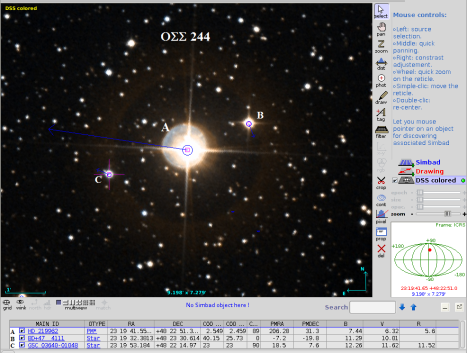
It’s true – a picture is worth a thousand words! Simbad’s proper motion data is at the bottom of the image in the columns labeled PMRA and PMDEC, and the super-imposed arrows on the individual stars are proportional to that data. The blue arrows on the B and C components are difficult to see, so click to enlarge the image. (Aladin image with Simbad data and additional labels added).
Again, for those not familiar with the way the proper motion data is presented, each of the numbers in those two columns represents thousandths of an arc second. So the first number in the PMRA column, which reads 206.29 is actually .20629”, and the number next to it in the PMDEC column, 31.3, is actually .0313” (multiply each number by .001). The absence of a plus or a minus sign indicates eastward motion in right ascension (RA) and northward motion in declination (DEC) (sometimes a “+” sign appears in front of the number in those cases, but it’s been left out here). A negative sign in front of the values indicates westward motion in RA and southerly motion in declination.
Frequently you’ll see the proper motion data is rounded to just three places, and the RA and Dec numbers are presented as a pair of three digit numbers. For example the WDS would list the numbers I mentioned above for the primary as +206 +031, the B component values as -007 -020, and the C component values as +019 +008.
Of course, you don’t need to know all of that to enjoy the celestial sights above, but on the other hand, when you peel back the outer layer of the heavens, you’ll find the secrets of the universe begin to reveal themselves one at a time. It’s always just a bit humbling to realize that vast vault of stars over our heads are constantly in motion relative to each other, even if it’s only at a snail-like pace of one thousandth of an arc second at a time. Change is constant, even when it’s imperceptible – and time is relative to the scale on which it occurs.
Clear Skies and tolerable temperatures! 😎
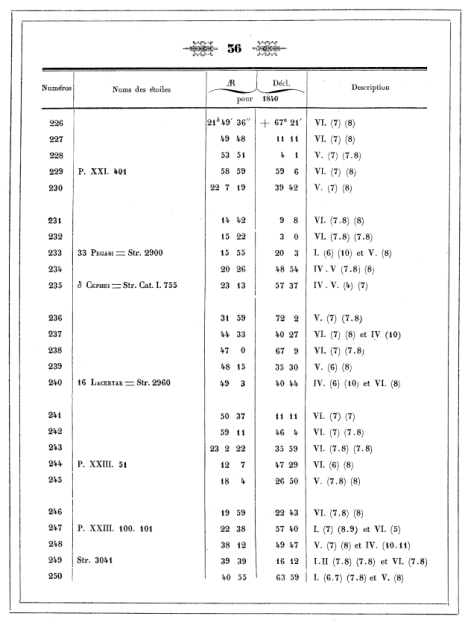
Page 56 of Otto Wilhelm von Struve’s 1845 Catalog. STTA 244 is the seventh star from the bottom of the page. The numbers in parentheses in the right hand column are estimated magnitudes. Click to enlarge.
Filed under: 4. Choose a Constellation:, Andromeda | 2 Comments »



